| Chronological overview |
| Notes |
| Appendices |
| References |
| Index |
Notes
During the collection and collation of the data of this website, the following discrepancies and questions came to light. Of course, all of these points are open for discussion ...
This inventory of illustrations is based purely on digital resources: scans of books and digital catalogues. I've based the dates in this website on the dates in articles that describe the illustrations. Most dates and sources are confirmed. However, some books are simply not scanned yet, or only later editions are digitally available. I have not been able to confirm the first dates of use of the following illustrations of wooden presses:
- 1509 Johann Schöffer. First scanned version: 1514?
- 1516 Petrus Cesar Gandavus. First scanned version: 1520
- 1520 Jodocus Badisu Ascensius. First scanned version: 1528
- 1555 Badius. First scanned version: 1556
- 1561 Gibier. First scanned version: 1571
- 1565 Roigny. First scanned version: 1579
- 1571 Gibier1. First scanned version: 1599
- 1578 Day. First scanned version: 1590
And I'm still looking for high resolution scans of:
- 1524 Jean Baudoin
- 1565 Michel de Roigny - 1
- 1581 Ralph Newbery
- 1620 William Jones
- 1641 Flesher, Young, and Hodgskinson
1. Jodocus Badius Ascensius. (Roche B1, Madan #2*)
Most sources date the first publication of this mark in 1507. However, the Universal Short Title Catalogue (USTC) dates it 1506. [USTC].
Concluding: The first date of the use of the printer’s mark of Jodocus Badius Ascensius was in 1506, not 1507.
2. Michel de Vascosan. (Roche G2, Madan #9.)
Nigel Roche lists the printers’ mark of Michel de Vascosan as G2. He follows Madan’s 1924 numbering of ‘9’, and refers to illustration 364 in the 1730 Thesaurus of Friedrich Roth-Scholtz. Roche describes on page 25: ‘A recutting of the earlier block, used by the Paris printer Michel de Vascosan, from 1535 to 1539. A close copy but the toe of the spindle is less clear.’
‘Madan (1895, page 231) describes this mark as: ‘9. 1535 at earliest. A copy of No. 4 was used as a device by Michael Vascosanus, printer at Paris from 1535 to 1539. Reproduced in Fridericus Roth-scholtzius’s Thesaurus symbolorum ... i.e. Insignia bibliopolarum et typographorum (Norimb. 1730), No. 364: the index to Sylvestre shows that this device was intended to be at No. 98, where, at least in some copies, another now occupies its place.’ Renouard (1928) states on page 348: ‘Emploie à ses débuts la marque n° 3 de son beau-père, Josse Badius (n° 24); il n'a pas de marque personnelle.’
I checked all scanned copies that were printed by Michel de Vascosan and that are mentioned in the USTC. Vascosan used Badius Ascensius 1506 mark in 1536 and 1538, and there is no indication that a different woodcut was used. The illustrations in Roth-Scholtz (1730) are fairly poor. A comparison of figure 113 and the original 1506 Badius Ascensius mark shows substantial discrepancies as well. Both figure 113 and 364 are included below.
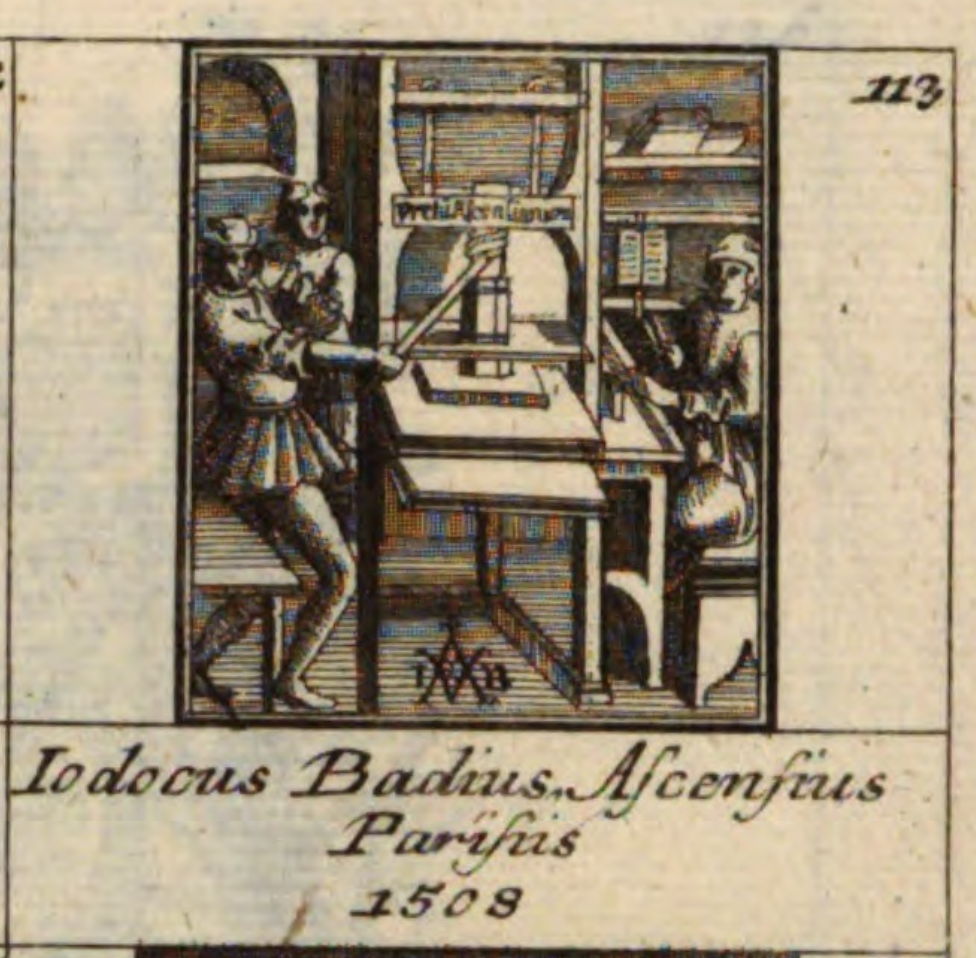
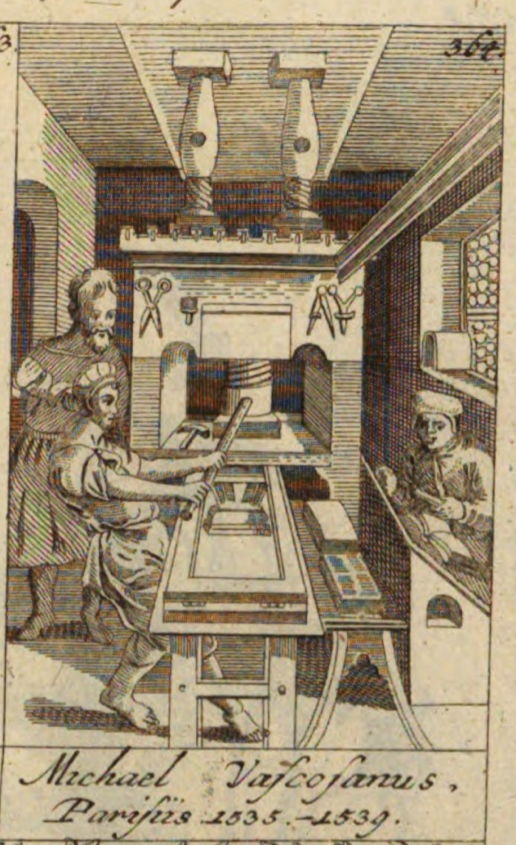
Concluding: The printers’ mark of Michael de Vascosan did not contain a new or other visualisation of a common press.
3. Georges Rognault. (Roche G3.)
The printer’s mark by Georges Regnault was dated 1546 by Nigel Roche. However, this mark was in use in 1529 by Denis de Harsy. The book was reprinted in 1546 by Georges Regnoult with the same woodblocks in a two-column version.
Concluding: The printers’ mark of Georges Regnault was used in 1529 by Denis de Harsy. The entry ‘Georges Regnault’ can be deleted.
4. Jodocus Badius Ascensius. (Roche H, Madan #7.)
Most sources date this publication 1529. However, the Universal Short Title Catalogue (USTC) dates it 1521. [Scan],
[USTC].
Concluding: The first date of the use of the printer’s mark of Jodocus Badius Ascensius was in 1521, not 1529.
5. Jean de Roigny. (Roche H1, Madan #8.)
The printer's mark by Jean de Roigny was dated 'Not before 1529' by Nigel Roche. This mark was in use in 1549 by Jean de Roigny. The available scans mentioned in the USTC do not show a use before 1549.
Concluding: The printers’ mark of Jean de Roigny - with the double cross at the puller’s heel - was used in 1549. It is not clear if it was used before 1549.
6. Anthony Scoloker. (Roche J1, Madan #13.)
Anthony Scoloker got this woodblock in 1548 from Josse Lambrecht. There do not seem to be any differences: it is the same woodcut.
Concluding: Numbers J1 in Nigel Roche and Madan #13 are deleted from the list.
7. Éloy Gibier. (Roche K2, Madan #15.)
It looks as if Éloy Gibier used two woodblocks from Conrad Badius. One with a ‘junior team’ that was used by Conrad Badius in 1548, and one with a ‘senior team’ that was used by Conrad Badius in 1555. The ‘senior team’ was used by Gibier in 1571, but I have not been able to find Gibier’s use of the ‘junior team’. The ‘junior team’ woodblock was used by Fabian Hotot in 1599.
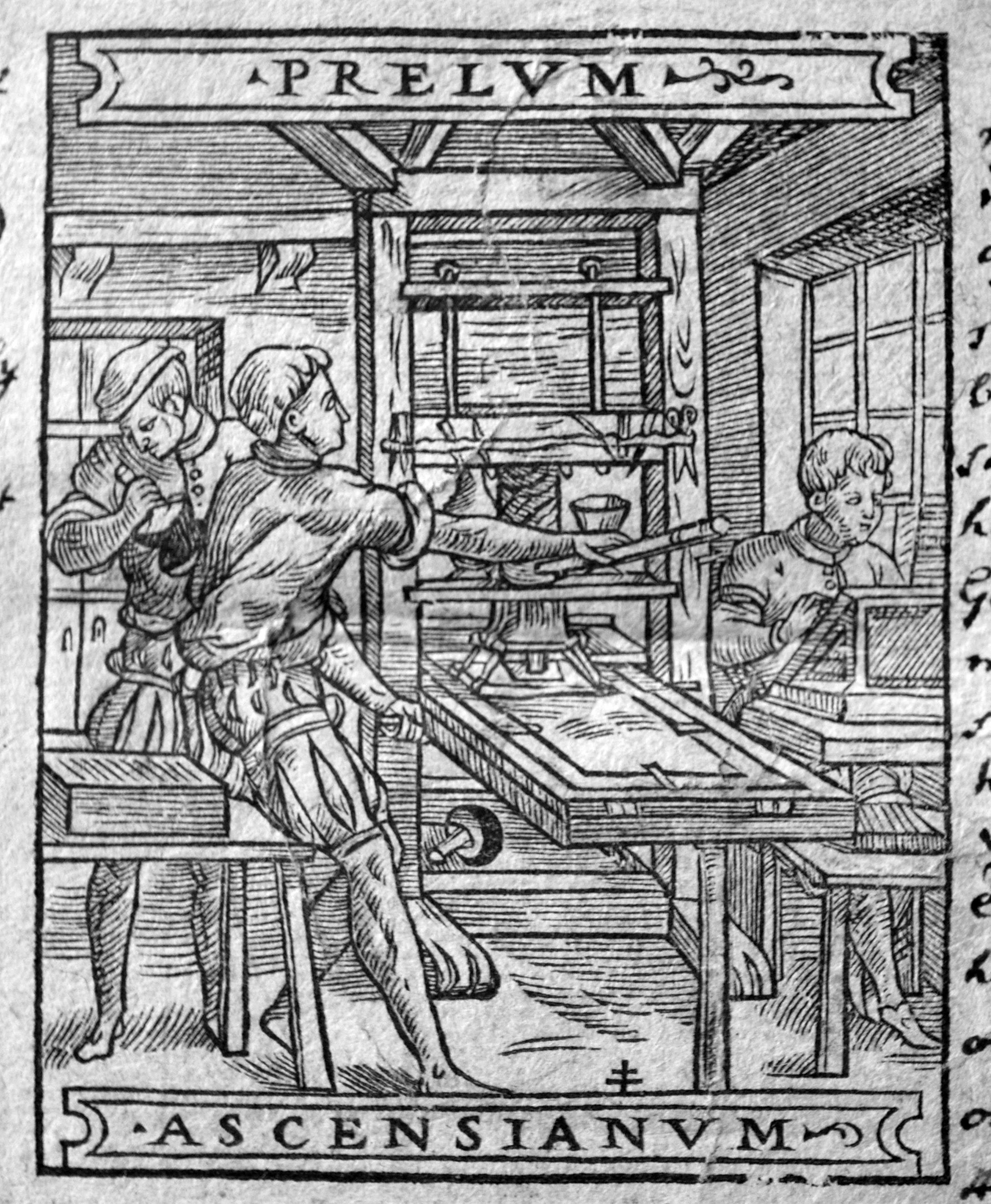
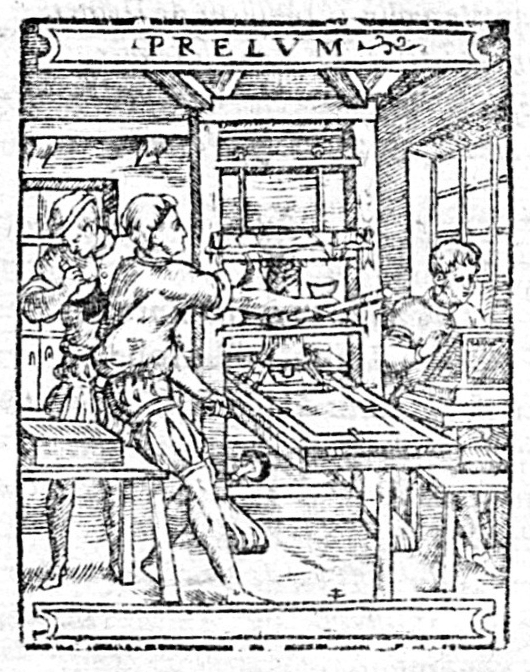
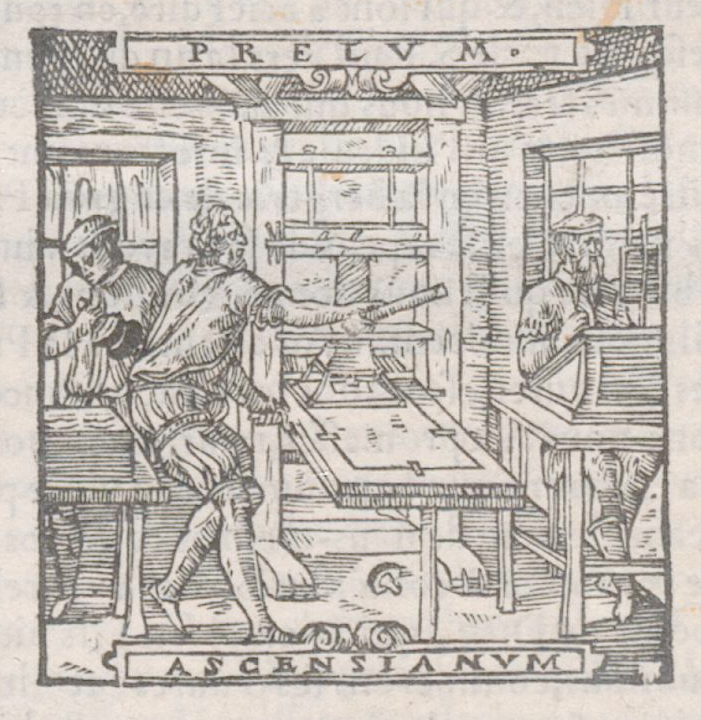
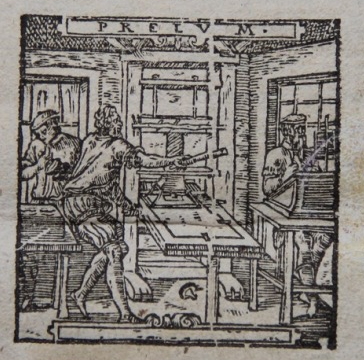
Concluding: It looks as if Gibier used only the ‘senior team’ woodcut. The ‘junior team’ was later used by Fabian Hotot.
8. ‘Inneres einer alten Druckerei’. (Roche N.)
Nigel Roche states (Page 45, N): ‘This view is included in good faith. It appeared in 1926 in an advertisement in a German printing trade magazine described as ‘Inneres einer alten Druckerei’; Holzstock aus den technischen Sammlungen des Deutschen Buchgewerbevereins’. Most of the issues of this journal are online. Unfortunately, 1926 is missing. The illustration should be in the April issue, facing page 292.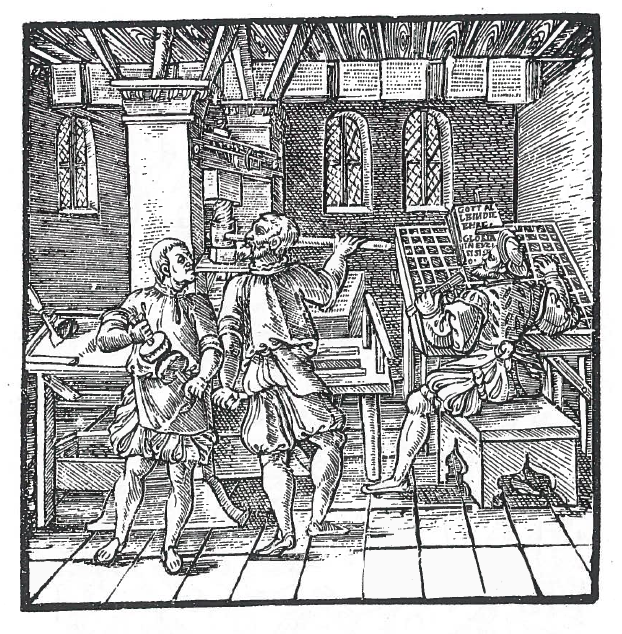
Concluding: Until more details are known, the illustration is not included in the list.
9. Unknown. (Roche P2, Madan #17.)
Nigel Roche (2000, page 47): ‘This is taken from John Johnson’s Typographica of 1824, where it is dated 1560.’ Falconer Madan (1895, page 235, #17): ‘Reproduced in J. Johnson’s Typographia, vol ii, p 498, but the source is not stated.’
It is an adaptation of the 1565 printer’s mark of Michel de Roigny. It is published by Thomas Frognall Dibdin in ‘Typographical antiquities’ (London, 1810). Dibdin writes: ‘Almost all of the plates of Ames, which Herbert indiscriminately admitted, are not only destitute of taste and skill, but are incorrect representations of the Originals. Fac-similes of the types and devices of printers are crowded together in a minute and irregular manner, and Printers’ Portraits are given with little fidelity, or elegance. In the present edition, it is proposed to remedy these defects; and to give accurate and well executed copies of the Originals.’ I have not yet found this reference in William Herbert's version of the Typographical Antiquities (1790, 3 volumes). 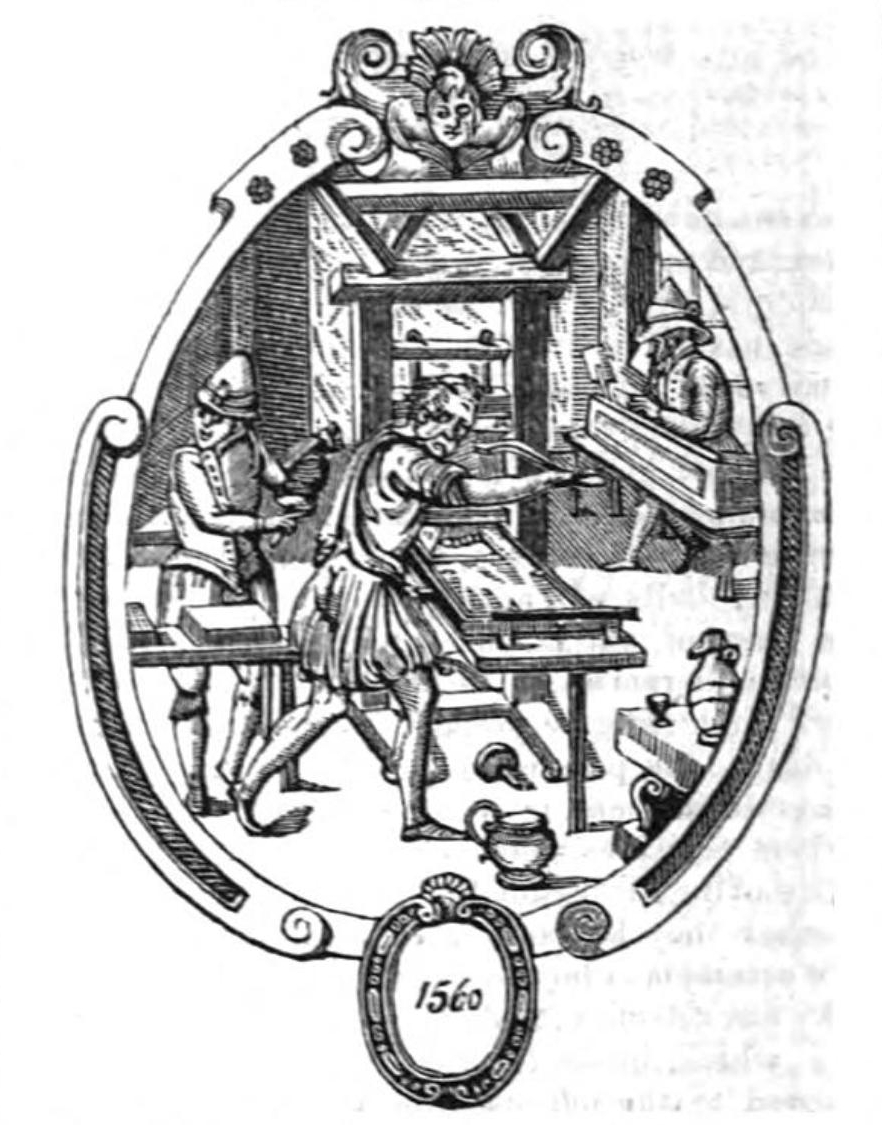
Concluding: Not included. It is a woodcut made for an 1810 publication, based on a printer’s mark of Michel De Roigny.
10. Terminology.
The STCN provides the following descriptions:
- Edition (Dutch: ‘druk’) = alle edities (exemplaren) die te eniger tijd van hetzelfde of grotendeels hetzelfde zetsel zijn gedrukt.
- Impression (Dutch: ‘Oplaag’) = deel van een druk dat alle exemplaren bevat die binnen één tijdsgeheel van de pers zijn gekomen.
- Issue (Dutch: ‘Uitgave’) = deel van een druk dat alle exemplaren bevat die zijn gepresenteerd als een opzettelijk van andere uitgaven onderscheiden publikatie-eenheid.
- State (Dutch: ‘Staat’) = exemplaren met andere dan boven omschreven kleine afwijkingen in het zetsel.
Concluding: Only ‘editions’ are included in this collection.